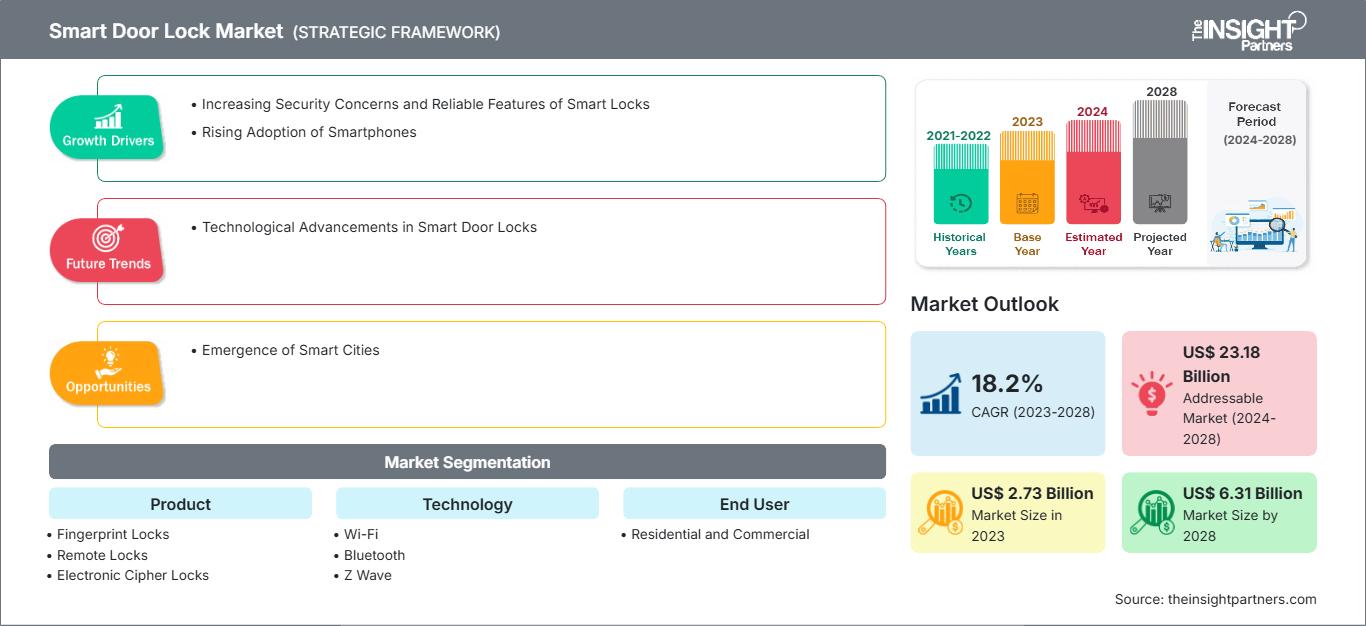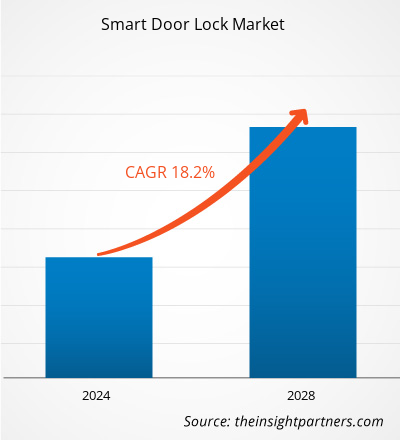[Rapporto di ricerca]Si prevede che il mercato delle serrature intelligenti crescerà da 2.733,05 milioni di dollari nel 2023 a 6.309,13 milioni di dollari entro il 2028; si stima che registrerà un CAGR del 18,2% dal 2023 al 2028.
Le serrature intelligenti sono sistemi di chiusura avanzati che forniscono un accesso sicuro e comodo a un edificio o a una stanza senza una chiave fisica. Le serrature intelligenti possono essere bloccate o sbloccate tramite metodi di autenticazione elettronica come il riconoscimento biometrico, codici numerici o segnali wireless. Le serrature intelligenti sono utilizzate in abitazioni residenziali, edifici commerciali, nel settore alberghiero, strutture scolastiche, strutture sanitarie e altri. La crescente tendenza e implementazione dell'Internet of Things (IoT) e la crescente preoccupazione per la sicurezza e la privacy stanno incrementando l'adozione di dispositivi di sicurezza domestica intelligenti in tutto il mondo. Si prevede che la crescente consapevolezza dei consumatori riguardo ai vantaggi delle soluzioni di sicurezza avanzate darà impulso al mercato delle serrature intelligenti.
L'aumento del numero di utenti di smartphone in tutto il mondo ha portato a un aumento della diffusione delle serrature intelligenti negli ultimi anni. Queste serrature sono dotate di un'interfaccia utente intuitiva e di un utilizzo pratico. La crescente consapevolezza relativa alle soluzioni per la sicurezza domestica, l'evoluzione dei dispositivi intelligenti come gli smartphone, l'aumento del reddito disponibile dei consumatori, l'aumento delle minacce alla sicurezza, lo sviluppo delle città intelligenti e la crescente connettività Internet contribuiscono ulteriormente alla crescita del mercato delle serrature intelligenti. Le serrature intelligenti integrano tecnologie di comunicazione come Bluetooth, Wi-Fi, Z-Wave, RFID e NFC.
Personalizza questo rapporto in base alle tue esigenze
Potrai personalizzare gratuitamente qualsiasi rapporto, comprese parti di questo rapporto, o analisi a livello di paese, pacchetto dati Excel, oltre a usufruire di grandi offerte e sconti per start-up e università
Mercato delle serrature intelligenti: Approfondimenti strategici

-
Ottieni le principali tendenze chiave del mercato di questo rapporto.Questo campione GRATUITO includerà l'analisi dei dati, che vanno dalle tendenze di mercato alle stime e alle previsioni.
Impatto della pandemia di COVID-19 sull'analisi del mercato globale delle serrature intelligenti
La pandemia di COVID-19 ha avuto un impatto drammatico sull'economia globale durante il suo picco nel 2020 e la crisi ha ostacolato le attività commerciali nei settori manifatturieri. Prima della pandemia di COVID-19, il mercato delle serrature intelligenti stava registrando una crescita sostanziale nei settori residenziale e commerciale grazie al continuo miglioramento degli standard di vita. Diversi settori, come quello dei semiconduttori e dell'elettronica, hanno dovuto affrontare sfide nello sviluppo di progetti, nelle spedizioni, nella produzione e nella ricerca e sviluppo di nuovi prodotti. Tuttavia, l'aumento della domanda di prodotti contactless dovuto alle misure di lockdown e di distanziamento sociale ha favorito il mercato delle serrature intelligenti.
La pandemia di COVID-19 ha avuto un impatto negativo sulle operazioni della catena di approvvigionamento, sulla spesa in conto capitale, sulla produzione e sulle strategie a lungo termine in diversi settori. I produttori hanno incontrato difficoltà nell'intraprendere attività di sviluppo aziendale a causa delle misure di quarantena emanate dai governi di diversi paesi, che hanno comportato cambiamenti nelle loro operazioni di routine. Inoltre, la pandemia ha costretto le aziende a ristrutturare i propri modelli di business, concentrandosi su strategie per raggiungere economie di scala. Questi fattori hanno ostacolato il progresso del mercato delle serrature intelligenti nel 2020.
Approfondimenti di mercato: analisi di mercato delle serrature intelligenti
I progressi tecnologici nelle serrature intelligenti stimoleranno la crescita del mercato nei prossimi anni
Diversi operatori del mercato delle serrature intelligenti stanno integrando l'intelligenza artificiale (IA), l'apprendimento automatico (ML) e altre tecnologie simili nelle loro serrature intelligenti. Le serrature integrate con IA e ML garantiscono una migliore sicurezza domestica monitorando chi apre e chiude le porte. Inoltre, queste serrature offrono un maggiore controllo su chi può bloccare e sbloccare le porte. Consentono inoltre agli utenti di bloccare o sbloccare automaticamente le porte quando escono o si avvicinano alle loro case. Le serrature integrate con IA o ML possono aiutare a riconoscere i tentativi di effrazione o manomissione. Di conseguenza, l'integrazione di tecnologie avanzate offre opportunità di crescita redditizie per gli operatori del mercato delle serrature intelligenti. Diversi operatori del mercato delle serrature intelligenti stanno lanciando nuovi prodotti che integrano tecnologie avanzate per soddisfare la crescente domanda di questo mercato. Nel dicembre 2022, Viomi ha lanciato la Viomi AI Smart Door Lock Super 2E. Questa serratura intelligente completamente automatica supporta sei metodi di sblocco: impronta digitale, password, password virtuale, password temporanea, tessera porta e chiave. È dotata di tecnologia di autoapprendimento AI, che diventa più sensibile con l'uso. Nell'aprile 2023, Geonfino ha lanciato tre nuove serrature intelligenti: la serratura per porta con impronta digitale Geonfino G4 Pro, la serratura intelligente Geonfino G4 Pro+G2 e la serratura intelligente Geonfino S1 Pro, dotate di un metodo di sblocco sei in uno, con impronta digitale, applicazione, password, tessera IC, chiave fisica e controllo del gateway. Nel febbraio 2023, Xiaomi ha presentato la sua nuova serie Xiaomi Smart Door Lock M20. Questo nuovo modello, Smart Guardian Can See, è dotato di una telecamera integrata e di un display che offrono agli utenti una visione completa della porta d'ingresso in tempo reale. Inoltre, il modello è dotato di una funzione campanello, rendendolo più pratico per gli utenti. Pertanto, l'introduzione di serrature intelligenti dotate di nuove tecnologie per migliorare la sicurezza alimenterà ulteriormente la crescita del mercato delle serrature intelligenti durante il periodo di previsione.
Mercato delle serrature intelligentiLe tendenze regionali e i fattori che influenzano il mercato delle serrature intelligenti durante il periodo di previsione sono stati ampiamente spiegati dagli analisti di The Insight Partners. Questa sezione illustra anche i segmenti e la geografia del mercato delle serrature intelligenti in Nord America, Europa, Asia-Pacifico, Medio Oriente e Africa, America meridionale e centrale.
Ambito del rapporto sul mercato delle serrature intelligenti
| Attributo del rapporto | Dettagli |
|---|---|
| Dimensioni del mercato in 2023 | US$ 2.73 Billion |
| Dimensioni del mercato per 2028 | US$ 6.31 Billion |
| CAGR globale (2023 - 2028) | 18.2% |
| Dati storici | 2021-2022 |
| Periodo di previsione | 2024-2028 |
| Segmenti coperti |
By Prodotto
|
| Regioni e paesi coperti |
Nord America
|
| Leader di mercato e profili aziendali chiave |
|
Densità degli operatori del mercato delle serrature intelligenti: comprendere il suo impatto sulle dinamiche aziendali
Il mercato delle serrature intelligenti è in rapida crescita, trainato dalla crescente domanda degli utenti finali, dovuta a fattori quali l'evoluzione delle preferenze dei consumatori, i progressi tecnologici e una maggiore consapevolezza dei vantaggi del prodotto. Con l'aumento della domanda, le aziende stanno ampliando la propria offerta, innovando per soddisfare le esigenze dei consumatori e sfruttando le tendenze emergenti, alimentando ulteriormente la crescita del mercato.

- Ottieni il Mercato delle serrature intelligenti Panoramica dei principali attori chiave
Diversi attori del mercato delle serrature intelligenti stanno lanciando serrature intelligenti avanzate per scopi di sicurezza avanzati, come segue:
- Nell'aprile 2023, Geonfino, un produttore di serrature intelligenti, ha lanciato tre serrature intelligenti, dotate di un esclusivo metodo di sblocco sei in uno per garantire la massima sicurezza e praticità. Le serrature intelligenti sono dotate di funzionalità biometriche e controllo vocale.
- Nel febbraio 2023, Xiaomi ha lanciato una serratura intelligente integrata con uno spioncino e uno schermo, che offre agli utenti una visione completa della porta d'ingresso in tempo reale.
Profilo dell'azienda:
- Adel Marketing (M) SDN BHD
- Allegion plc
- Assa Abloy
- Guangdong level intelligent lock industrial co ltd
- Honeywell International Inc
- Spectrum Brands
- Locstar Technology Co Ltd
- Master Lock Company LLC
- Miwa Lock Co, Zigbang
- Analisi storica (2 anni), anno base, previsione (7 anni) con CAGR
- Analisi PEST e SWOT
- Valore/volume delle dimensioni del mercato - Globale, Regionale, Nazionale
- Industria e panorama competitivo
- Set di dati Excel
Report recenti
Rapporti correlati
Testimonianze
Motivo dell'acquisto
- Processo decisionale informato
- Comprensione delle dinamiche di mercato
- Analisi competitiva
- Analisi dei clienti
- Previsioni di mercato
- Mitigazione del rischio
- Pianificazione strategica
- Giustificazione degli investimenti
- Identificazione dei mercati emergenti
- Miglioramento delle strategie di marketing
- Aumento dell'efficienza operativa
- Allineamento alle tendenze normative






















 Ottieni un campione gratuito per - Mercato delle serrature intelligenti
Ottieni un campione gratuito per - Mercato delle serrature intelligenti